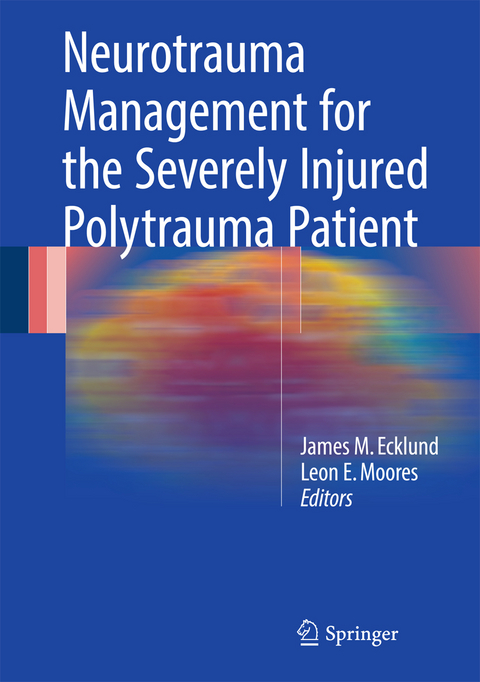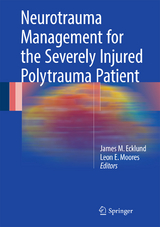Neurotrauma Management for the Severely Injured Polytrauma Patient
Springer International Publishing (Verlag)
978-3-319-40206-2 (ISBN)
James M. Ecklund, M.D., F.A.C.S. serves as Chairman of the Inova Neuroscience Institute. Prior to joining Inova Medical Group, he served as Professor and Chairman of the Neurosurgery Program of the National Capital Consortium, which includes Walter Reed Army Medical Center, National Naval Medical Center and the Uniformed Services University. He is a retired colonel in the U.S Army and was deployed as a Neurosurgeon to both Afghanistan and Iraq. His program received the vast majority of American neurotrauma casualties.Dr. Ecklund’s primary clinical and research interests include complex spine, cerebrovascular disease and neurotrauma with an emphasis on blast and penetrating injury. He directs a neurotrauma laboratory at the Uniformed Services University, has over 100 publications and abstracts, and has lectured throughout the world. He also has served on multiple oversight and advisory boards for the Veterans Administration, Department of Defense, National Institutes of Health, NATO, Neurotrauma Foundation, and Brain Trauma Foundation.Leon E. Moores, MD, MS, FACS is the CEO of Pediatric Specialists of Virginia and the Associate Chair for Pediatric Programs at the Inova Neuroscience Institute. He retired as a Colonel from the US Army where he led as an Infantry Platoon Leader, Chief of Neurosurgery at Walter Reed, Chairman of the Department of Surgery at Walter Reed, Deputy Commander of the National Naval Medical Center, and Commander of the Fort Meade Medical System. Dr Moores also served two tours of duty in Afghanistan and Iraq. Dr Moores’ clinical and research interests center on brain and spinal tumors in children, CNS infections in combat soldiers, and complex craniofacial reconstruction in severe head and facial trauma. He is a Professor of Surgery and Pediatrics at the Uniformed Services University, and a Professor of Neurosurgery at Virginia Commonwealth University.
The Difficult Conversation.- Communication Between Teams and Multidisciplinary Rounds and Single Primary POC for Family Communication - Lessons Learned and Who's in Charge?.- Mass Casualty Events and Your Hospital.- Rural and Austere Environments.- Prehospital Care and EMS Considerations in the Polytrauma Patient with CNS Injuries.- AIS vs. ISS vs. GCS - What's Going On Here?.- Trauma Resuscitation and Fluid Considerations in the Polytrauma Patient with CNS Injury.- Initial Imaging Considerations, Repeat Imaging Frequency.- Evidence Based Review of the Use of Steroids in Neurotrauma.- Interventional Radiology in the Civilian Neurotrauma Setting.- Vertebral artery injuries in penetrating neck and cervical spine trauma.- Clearing the Cervical Spine in Blunt Trauma.- Initial evaluation and management.- Transport of the Neurotrauma Patient.- Multiple Surgical Teams in the O. R. at Once - Priority of Effort and Who Takes the Lead?.- Laparotomy for refractory ICP.- Associated Musculoskeletal Injuries.- Neuro Anesthetic Considerations.- Decompressive Craniectomy for Severe TBI.- Hemodynamic Considerations in the Polytrauma Patient with Traumatic Brain Injury (TBI).- Coagulopathy in Traumatic Brain Injury.- Venous Thromboembolism Prophylaxis.- Mechanical Ventilation in Traumatic Brain Injury.- Nutrition, Antibiotics, and Posttraumatic Seizure Prophylaxis.- Therapeutic Hypothermia for Traumatic Brain Injury and Spinal Cord Injury.- Rehabilitation in the setting of Neuro-Trauma.- Craniofacial Reconstruction in the Polytrauma Patient.- Functional Restoration for Neurological Trauma: Current Therapies and Future Directions.- Pediatric Neurotrauma.- Care of Patients with Burns and Traumatic Brain Injury.
"The purpose is to describe the integration of management for neurological injuries into the care of patients with trauma to multiple organ systems. Senior trainees with an interest in trauma or providers in a multidisciplinary trauma practice are an appropriate audience. ... a useful guide for neurosurgeons and those in other disciplines addressing injury. Neurosurgeons will better understand what to expect from other trauma team members, while the trauma team will have data describing optimal protection of the brain." (David J. Dries, Doody's Book Reviews, March, 2017)
| Erscheinungsdatum | 14.09.2016 |
|---|---|
| Zusatzinfo | XVIII, 340 p. 63 illus., 25 illus. in color. |
| Verlagsort | Cham |
| Sprache | englisch |
| Maße | 178 x 254 mm |
| Themenwelt | Medizinische Fachgebiete ► Chirurgie ► Neurochirurgie |
| Medizin / Pharmazie ► Medizinische Fachgebiete ► Intensivmedizin | |
| Schlagworte | Craniofacial reconstruction • Decompressive craniotomy • Exploratory burr holes • Intensive / Critical Care Medicine • Interventional Radiology • Medicine • Neurodiagnostics • neurosurgery • Trauma Resuscitation • trauma surgery • Traumatic Surgery |
| ISBN-10 | 3-319-40206-4 / 3319402064 |
| ISBN-13 | 978-3-319-40206-2 / 9783319402062 |
| Zustand | Neuware |
| Informationen gemäß Produktsicherheitsverordnung (GPSR) | |
| Haben Sie eine Frage zum Produkt? |
aus dem Bereich




